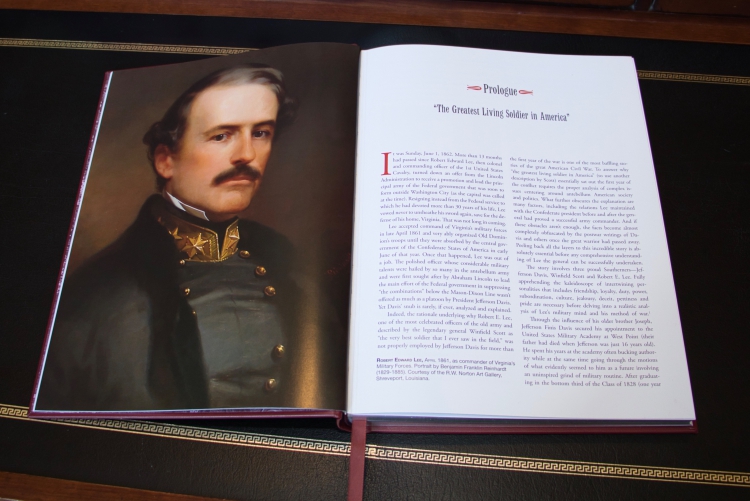Category: Blog
What’s new in the second edition of Armies at Waterloo update #2
By Scott Bowden
Armies at Waterloo has always been known for its exacting orders of battle, including numbers of officers and other ranks present and under arms, as well as precise information on the ordnance comprising each artillery battery/company/troop. The greatly expanded second edition provides even more details, with the orders of battle as well as the ordnance present with each army—including the notes from inspection reports, when available.
The Great War card game playtesting update – September 2019
MacGowan & Lombardy’s The Great War was completely funded on Kickstarter and will ship in April 2021
Further refinements have been made since this playtest. Click here to go to a report that links to the latest rules, overview & card samples, examples of play, and quickplay rules.
Based on player feedback at Consimworld Expo 2019 we made some important changes to the World War One card game.
Here is a brief overview of what we changed –
1) We kept a color border on the card back only for the Random Events deck (orange) since these cards never go into a player’s hand.
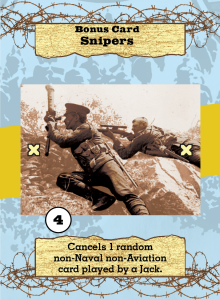 2) All other deck colors (new Bonus deck yellow, red/blue core decks, and white additional-optional deck) are now on the card fronts. They appear as a broad, wide diagonal stripe across the middle of each card. This enables quick sorting but won’t tell your opponent what you are holding in your hand.
2) All other deck colors (new Bonus deck yellow, red/blue core decks, and white additional-optional deck) are now on the card fronts. They appear as a broad, wide diagonal stripe across the middle of each card. This enables quick sorting but won’t tell your opponent what you are holding in your hand.
3) We changed most naval cards to BLOCKADE cards (Allied surface ships and German submarines). They still have low battle points. Now they have a bigger impact on the game. If a blockade card is still in play at the end of a turn, it cancels and discards any one enemy Nationality card. This reflects the blockade’s long term logistical effects. Naval cards cannot help capture army or aviation cards – instead they remove them from play. Chris Janiec suggested these revised rules. Chis is a US Navy veteran and designer of PQ17 published by GMT. We will credit him as naval rules developer.
4) A turn winner cannot place high value aces, kings, queens, and jacks back into their hand. Nor can they be voluntarily discarded. This would enable a player to avoid their capture by the enemy. These cards now show their battle point (BP) values as white numbers inside a black circle.
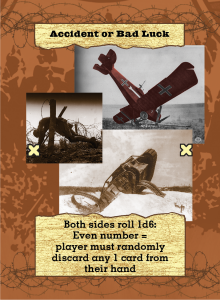 5) We now consider Heavy Machine-Gun (HMG) cards as another type of infantry. Therefore, cards that link to infantry now also link to HMG. This text fix appears on all appropriate cards.
5) We now consider Heavy Machine-Gun (HMG) cards as another type of infantry. Therefore, cards that link to infantry now also link to HMG. This text fix appears on all appropriate cards.
6) All mortars and howitzers now include the word “artillery” so their card type is clear. Field guns are now called field artillery.
7) We have added dates to the new white deck cards. For example, all USA cards now have 1918 on them.
8) The number of cards a player may have in their hand increased from 8 to 9.
9) Dana is working on a game overview with designer’s notes and player tips. These, and the new four levels of victory, will appear on the back of the new version of the Quick Play Outline.
These changes slightly shortened the amount of rules text.
Click here to download a PDF of the latest rules (4.7) and sample cards.
Update on MacGowan and Lombardy’s The Great War™ Card Game
UPDATE DECEMBER 7, 2020
MacGowan & Lombardy’s The Great War was completely funded on Kickstarter and will ship in April 2021
Hello, playtesters.
My apologies for not sending out updates on the card game in 2018. Read the reasons below for the delay, and how that helped improve the game.
November 2017
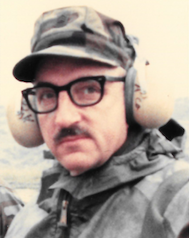 The following occurred after my last 2017 update to the playtesters.
The following occurred after my last 2017 update to the playtesters.
On 18 November 2017 fellow founder and editor of my Conflict magazine from the 1970s was found dead in his home. He was 71, but this was still unexpected.
Master Sergeant “TP” Schweider, USMCR (Ret.) lived in Twentynine Palms (southern California) where I occasionally visited him. TP’s only family was a few friends like me that he had “adopted” over the years. He was a good friend and mentor.
Over several months I helped rescue TP’s five cats and clear out his house. He is missed. He will be remembered.
January 2018
Professionally, the New Year brought an opportunity, one that rapidly consumed most of my time for the rest of the year. This work proved very valuable to the development of the card game (explained at the end.)
In January of last year, I became a member of the World War I Armistice Centennial Commemoration Committee. The non-profit San Francisco War Memorial and Performing Arts Center Foundation formed the Committee in late 2017. The Foundation administrates the War Memorial Opera House (where the SF ballet performs), Davies Symphony Hall, the Herbst Theater, and War Memorial Veterans Building. The Veterans Building was dedicated in 1932 to honor veterans of the Great War.
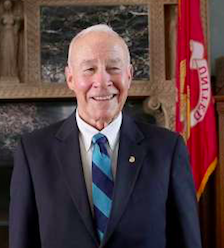 The chair of the Committee is Major General J. Michael Myatt, USMC (Ret.) who is a trustee on the board of the Foundation. He is a Vietnam veteran and was commander of the 1st Marine Division that liberated Kuwait during Operation Desert Storm in 1991. It is an honor to serve on this Committee.
The chair of the Committee is Major General J. Michael Myatt, USMC (Ret.) who is a trustee on the board of the Foundation. He is a Vietnam veteran and was commander of the 1st Marine Division that liberated Kuwait during Operation Desert Storm in 1991. It is an honor to serve on this Committee.
My first task was to explain to the Foundation’s board of trustees why the war was so important and still affected Americans today. I gave two brief talks that were well received. I turned one of those PowerPoint presentations into a video for the exhibit.
I became the historical consultant and helped create the exhibits and displays for the War Memorial. My job was to explain America’s role in the Great War and its impact of transforming the United States into a major world power. I immersed myself in researching the history of the period. I wrote and edited the text for the signs and displays. I located appropriate photos and images, and produced a video.
May 2018
 By Memorial Day weekend eight large banners hung in the lobby of the Herbst Theatre. These banners tell the story of America’s initial desire to stay out of a foreign war in 1914. They go on to tell of the growing sympathy for the victims and refugees, and the horror at the unprecedented numbers of casualties. The story finally turns to the United States joining the Allies as a co-belligerent.
By Memorial Day weekend eight large banners hung in the lobby of the Herbst Theatre. These banners tell the story of America’s initial desire to stay out of a foreign war in 1914. They go on to tell of the growing sympathy for the victims and refugees, and the horror at the unprecedented numbers of casualties. The story finally turns to the United States joining the Allies as a co-belligerent.
There are also banners about women, financing the war, combat and technology, and ending the war (the Armistice). The final banner explains the creation and dedication of the War Memorial buildings to honor “all who served.”
All eight banners can be viewed on the American Legion website: https://alwmcsf.org/ww1/
October 2018
In 2018, General Myatt asked me to present my “Why is World War One Important” talk to a Senior Leaders Seminar during Fleet Week. These men and women included emergency responders, politicians, and conference participants from the Navy, Marines, and Army Corps of Engineers.
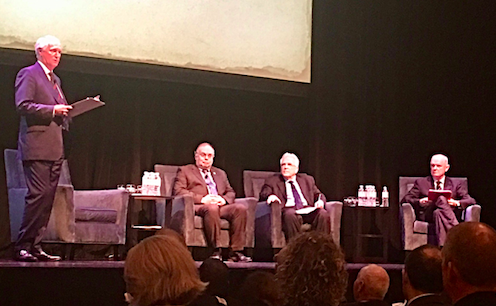
Christopher Oldfield, Australian Consul General in San Francisco (on my left), and Rear Admiral Sam Cox, U.S. Navy (Ret.), Director of Naval History and Heritage Command. Standing is the panel host Brigadier General Roderick Macdonald. British Royal Army (Ret.). Macdonald commanded 59 Independent Commando Squadron, Royal Engineers, during the Falklands War.
I then served on a panel about World War One.
In addition to the amount of work outlined above and for the soon-to-open Veterans Gallery exhibit, I helped design a set of eight commemorative cachets. These went on sale in October. They are collectible envelopes featuring the “Turning the Tide” Forever™ postage stamp. The U.S. Postal Service issued the stamp in 2018 to commemorate the 100th anniversary of the 1918 Armistice.
The cachet team included General Myatt, Ed Flowers, a Director of San Francisco Fleet Week and a member of the San Francisco Marines’ Memorial Club, and me. Flowers is a stamp aficionado who designed the Buffalo Soldiers cachet (among others) and worked with General Myatt on the 2005 release of the four Distinguished Marine postage stamps on the 230th birthday of the U.S. Marine Corps.
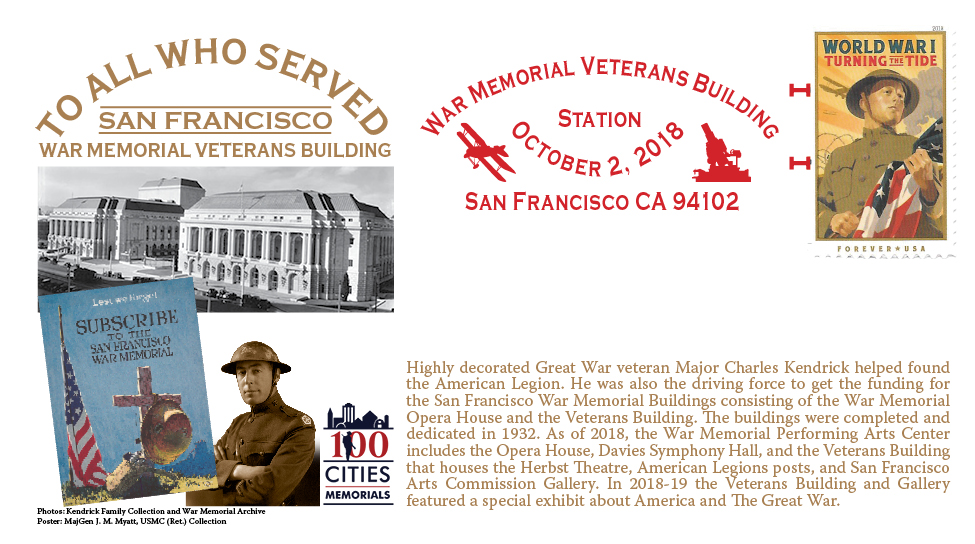 These eight “Turning the Tide” cachets feature historical Great War illustrations of the U.S. Marine Corps, Army, Navy, Air Service, African Americans, women, and animals. Charles Kendrick and the San Francisco War Memorial buildings are also included. You can see them here:
These eight “Turning the Tide” cachets feature historical Great War illustrations of the U.S. Marine Corps, Army, Navy, Air Service, African Americans, women, and animals. Charles Kendrick and the San Francisco War Memorial buildings are also included. You can see them here:
https://lombardystudios.com/commemorate-remember-world-war-one/
November 2018
The Armistice signed in 1918 marked the end of the war for America. The Eleventh hour of the eleventh day of the eleventh month became a remembrance day for the United States, France, Britain, Canada, Australia and New Zealand. It evolved into today’s Veterans Day in the U.S.
On November 11, 2018 the exhibit called The Great War / World War One – The American Experience opened. It is located in the Veterans Gallery, at the end of the lobby of the War Memorial Veterans Building. The exhibit includes hundreds of artifacts including uniforms, trench art, weapons and equipment, two videos, an aerial dogfight diorama, and dozens of images with descriptive text and stories.
 The United States World War I Centennial Commission chose San Francisco’s War Memorial Veterans Building as one of its 100 Cities / 100 Memorials matching grant. This was awarded to preserve World War I Centennial Memorial monuments.
The United States World War I Centennial Commission chose San Francisco’s War Memorial Veterans Building as one of its 100 Cities / 100 Memorials matching grant. This was awarded to preserve World War I Centennial Memorial monuments.
I assembled a team to videotape and photograph the banners and exhibit displays. I am now working on an augmented video tour that we will eventually post on YouTube. You could then visit the exhibit online even after it closes later in 2019. The banners will remain on permanent display on the second floor.
June 2019
I continue to serve on the renamed Veterans Commemoration Committee. Plans include projects to honor the veterans of the Korean War, World War Two, Vietnam, etc.
Visiting the Banners and Exhibit
The public can view the banners when the War Memorial Veterans Building is open. Hours are from 8 am to 10 pm Monday-Sunday. They are open later if there are building activities. In early July, they will move to the second floor for permanent display outside the offices of the American Legion. The Legion is an an organization formed in 1919 by the veterans of the Great War.
As noted before, you can see the eight banners on the American Legion website: https://alwmcsf.org/ww1/
The Great War / World War One exhibit in the Veterans Gallery is open to the public. Admission is free. You can find their hours at https://alwmcsf.org/gallery/ww1_exhibit2/ .
If you’re visiting the area, I am available to give tours.
How All of this Affected MacGowan and Lombardy’s The Great War Card Game
Based upon your feedback, the game improved to version 3 in 2017. Mark Kaczmarek’s development of the game, plus my past year of research for the Committee, has given the game:
• A greater variety of cards and images.
• Cards representing more nations and a greater number of weapons such as seaplanes and seacoast artillery.
• Random Event cards such as bad weather and bad luck.
• Bonus cards for terrain, improvements to weapons and doctrine, etc.
The extra cards allow for more scenarios (some cards are planned as stretch goals for the Kickstarter launch).
I hope these changes make the game more challenging—but remain a fun “filler” game.
Dana
Robert E. Lee at War: Hope Arises from Despair

Robert E. Lee at War:
Hope Arises from Despair
Robert E. Lee at War SeriesGenre: History, Civil War
Legion of Honor PublishingPublished: 2017Hardback
320 + xi pages, 29 color maps plus a large fold out map, five appendices, annotated endnotes, index Reviewed by Dana Lombardy
ISBN 978-0-692-86742-6 $200.00
Leeatwar.com
Full disclosure: This reviewer has known Scott Bowden since the 1970s and helped edit two of his Napoleonic books published in 2006 and 2009 by Military History Press.
Robert E. Lee at War: Hope Arises From Despair is a beautifully produced, full-color, large-format 9-by-12-inch art book. It has gold leaf leather binding, bound-in bookmark ribbon, and the page edges in gold foil. The collector’s edition of Lee also includes a gold leaf slipcase. It is the first volume produced by Legion of Honor Publishing.
This is an amazing book. Not only in the excellence of the binding and printing, but also in the well-researched and thoughtfully presented story of Robert E. Lee’s ascension to command in June of 1862 of what would arguably become the most important of the Confederate armies: the Army of Northern Virginia. Bowden used unpublished manuscripts, papers, and special collections as well as official records and memoirs.
Bowden acknowledges in his preface that the study of the American Civil War, and particularly Confederate leaders, is contentious today. However, these works provide important historical information vital to understanding why “The War” lasted so long. Bowden explains that “the careful study and analysis of the facts connected to Robert E. Lee’s military leadership—his mind and method—is the purpose of the Robert E. Lee at War series.”
During the Mexican War 1846-48 Lee’s abilities impressed Winfield Scott while Lee served under him. In 1861 Scott tried to get Lee to accept field command of the U.S. Army. Lee instead chose to serve his native state of Virginia. If Scott regarded him so highly, why was Lee so under employed for the first 13 months of the war? Although he was officially President Jefferson Davis’s advisor beginning in the spring of 1862, Lee only received a field command when Joseph E. Johnston was wounded during the fighting outside Richmond. The prologue by Bowden is a fascinating explanation that many readers may find surprising.
Part I includes the first nine chapters of the book and cover the Seven Days campaign which saved Richmond from capture by the Federal Army of the Potomac. It was an unprecedented turn around that Bowden’s exceptional storytelling describes using eyewitness quotes. Combined with the in-depth original analysis, this book is not your typical military history.
When Lee took command on June the 1st he inherited an army that was no better than an “armed mob” seriously lacking in discipline and cohesion. He met with his senior generals on June the 2nd, drastically improving the supplies and morale of the troops with personal inspections. He made repeated personal reconnaissances (as he did in Mexico), devised a counter offensive, and then executed it starting on June the 26th, not even a month after meeting with his division commanders.
Lee then fought five major battles in seven days, seizing the initiative in the campaign and driving the Federals from Richmond. It was a most remarkable accomplishment. Bowden shows how Lee’s methods and maxims were influenced by his study of Napoleon and other great commanders of history. Each of these battles employs multiple color maps and interesting sidebars such as the composition of the opposing artillery forces.
Part II includes the final three chapters of the book. This section is titled “Lee’s Art of War” and is the first to explain the underpinnings of Lee’s military philosophy. It also explains how he executed it in the areas of operational warfare and grand tactics on the battlefield.
The next volume in the series deals with Lee’s campaign and victory at the Battle of Second Manassas (Bull Run) in late August. This occurred just two months after the end of the Seven Days.
When President Lincoln asked Winfield Scott why 100,000 men could not take Richmond, Scott explained “The men who took us into the City of Mexico are the same men who are keeping us out of Richmond.”
Highly recommended.
Dana Lombardy
The Great War Revealed in San Francisco
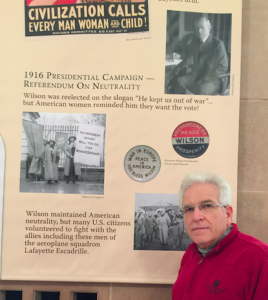 By Dana Lombardy. In February I was asked by the World War One Centennial Commemorative Committee to help create 100th anniversary exhibits that explain America’s role in World War One.
By Dana Lombardy. In February I was asked by the World War One Centennial Commemorative Committee to help create 100th anniversary exhibits that explain America’s role in World War One.
In late May 2018, they installed eight 8-foot square banners in the lobby outside the Herbst Theatre and American Legion Veterans Hall. This is in the War Memorial Veterans Building at 401 Van Ness Avenue. It’s across the street from San Francisco City Hall. The display is free to the public. You can view it at http://alwmcsf.org/ww1/. In 2019 the banners were moved to the second floor.
The Banners Have a Story to Tell
The banners tell the story of America’s initial desire to stay out of a foreign war in 1914. Then the growing sympathy for victims and refugees, horror at the unprecedented numbers of casualties. Then finally the United States joining as a co-belligerent in that war.
It was the first war that saw the widespread use of mechanization. Submarines, airships and airplanes, artillery cannon, machine-guns, tanks, and poison gas were all used. The lethality of these weapons drove armies underground. Soldiers lived for years in dugouts and trenches, separated by a devastated “No Man’s Land” of shell holes and barbed wire.
Millions of American women volunteered to work on farms, in factories, and in many other traditional male jobs. These women replaced nearly five million American men who entered into the U.S. Army and Navy. Women’s service in the war provided key political leverage to get the right to vote. Congress passed the 19th Amendment in 1919, with states’ ratification in 1920.
 The initial banner display in 2018 was supported by videos and additional exhibits of artifacts and photographs set up in the Veterans Gallery on the lobby level. There was also a series of seminars. The banner exhibit ran through the end of 2019 to commemorate the centennial of the Versailles Treaty (June) and founding of the American Legion.
The initial banner display in 2018 was supported by videos and additional exhibits of artifacts and photographs set up in the Veterans Gallery on the lobby level. There was also a series of seminars. The banner exhibit ran through the end of 2019 to commemorate the centennial of the Versailles Treaty (June) and founding of the American Legion.
Who Did This?
The United States World War I Centennial Commission chose San Francisco’s War Memorial Veterans Building as one of its 100 Cities / 100 Memorials matching grant. This award helps preserve monuments with the designation as a World War I Centennial Memorial.
The Performing Arts Center Foundation authorized the World War One Armistice Centennial Committee that created The Great War display. The Foundation administers the War Memorial Veterans Building complex that houses the American Legion and Veterans of Foreign Wars, Herbst Theatre, Opera House, and San Francisco Ballet. The Committee chairman is Major General J. Michael Myatt, USMC (Ret.), with co-chair Judge Quentin L. Kopp (Ret.), President of the Korean War Memorial Foundation.
On 11 November 2018, the 100th anniversary of the Armistice (now called Veterans Day in the USA), the second part of The Great War exhibit opened in the Veterans Gallery of the War Memorial Veterans Building. It also is free to the public. Dana is available for tours and is working on preserving the exhibit as an interactive video.




